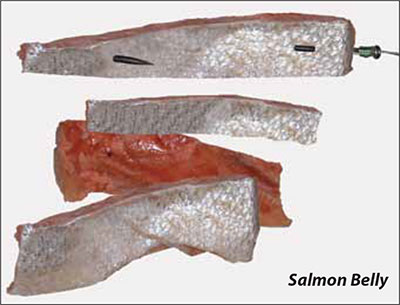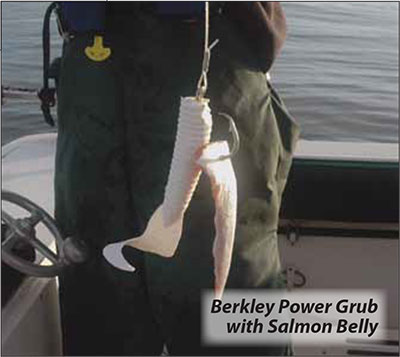
February 28th, 2018 – DFO Halibut notice at the bottom of this article.
This article appeared in the May 2016 Issue of Island Fisherman magazine, some photos updated, Bamfield 2017.
When choosing fresh bait to dredge along the bottom for deep-water species like halibut, lingcod and yelloweye rockfish, you should consider the findings of the US National Marine Fisheries Service, which conducted extensive research on the Alaskan commercial longline halibut fishery. By working from inside submersible vessels, the scientists were able to closely observe what actually happened to the baited hooks suspended from the longlines.
The aroma of fresh herring quickly attracted various fish species and other creatures like snails, starfish and crabs. Being soft, however, it disappeared so rapidly that the scientists found it difficult to estimate the loss rate. Pieces of octopus and Pacific grey cod stayed on the longest, which was attributed to neither of them attracting much interest rather than anything to do with their durability. The best all-round bait by far was salmon. Its scent quickly attracted interest, and its durability meant that it stayed on the hook longer. Remember this the next time you fillet or clean a salmon, and save all scraps with the skin intact—especially the white-skinned belly meat—and also save the heads and skeletal remains of smaller salmon like pinks and sockeye.
2018 update: While some prefer squid, my personal favourite is salmon belly, as fresh as possible. That, on a spreader bar is enough for me. —Joel Unickow


Another source of bait is salmon (or other fish) that has become freezer-burnt due to extended or improper storage. Although unpalatable as table fare, halibut will still find it quite edible.
Pretty well anything edible works for bait—anchovies, needlefish (sandlance), pilchards (sardines), shiner seaperch, butter and horse clam necks, squid, shrimp and prawns. Even “unnatural baits” work on occasion, for there are many accounts of halibut biting on fresh beef, pork and chicken flesh, garlic sausage and Smoky wieners.
 Fresh or frozen squid can be used whole or in pieces, butbeing fairly soft they rate no better than herring for longevity on a hook. While it’s impossible to prevent squid from being torn loose by bait-stealers, the process can be slowed to a manageable level by using two hooks in tandem, and then crisscrossing the hooked bait with tight wraps of thread or dental floss. Cut about three feet of thread. Half hitch one end around the leader ahead of the front hook’s eye, leaving a tag end four inches long. This is important, for it serves as the anchor point.
Fresh or frozen squid can be used whole or in pieces, butbeing fairly soft they rate no better than herring for longevity on a hook. While it’s impossible to prevent squid from being torn loose by bait-stealers, the process can be slowed to a manageable level by using two hooks in tandem, and then crisscrossing the hooked bait with tight wraps of thread or dental floss. Cut about three feet of thread. Half hitch one end around the leader ahead of the front hook’s eye, leaving a tag end four inches long. This is important, for it serves as the anchor point.
As squid swim backwards, insert the front hook through the tail, and then the trailing hook through the head. After positioning it, wrap the thread rearward, covering the body and binding it tightly to the hooks and line, then forward again to the tag end of thread. Tie the two ends together and you are in business.
Bait Bags
While preparing small bags of salmon roe for winter steelhead fishing, a friend got the idea of covering herring chunks with the strong, red mesh. He later discovered that while the material will eventually tear, it lasts long enough to make herring a viable bait for use with spreader bars or jigs. Yet another tact is to stuff a ball inside a hoochy. If the ball’s diameter is slightly larger than the inside diameter of the hoochy, the flexible plastic will stretch enough to hold the bait firmly in place, where it can produce a scent trail.

Bait balls can also be made with other fish scraps, chopped squid, clams or mussels, or crushed shrimp or prawn heads with the sharp spines broken off. Place a golf-ball-sized mound of bait in the centre of a 4-inch square of material, fold the material up over the top, then bind it tightly with strong thread or dental floss. Bait balls can be frozen prior to use. For even more durable bags, use pieces of nylon panty hose.
Unlike the attention to detail required for preparing and rigging cutplug or herring strips for Chinook and coho salmon, neatness doesn’t count much where bottom fish are concerned. Just remember that while bait often outfishes lures, it also attracts increased interest from dogfish. Whenever these pesky little sharks prove to be a nuisance, consider switching to a leadhead jig, pipe jig or a drift-jig.
 Years ago, Berkley increased the length of their curly-tailed Power Grub to 8-inches. It was biodegradable, loaded with scent, available in a range of colours, and had a large, crescent- shaped tail that wiggled enticingly when drawn through the water. Needless to say, other manufacturers are now offering similar soft plastic action baits, which gives anglers an even wider choice from which to choose. If you think that larger baits attract larger fish, Delta Bait offers a wide range of curly-tailed baits, including their 10- and 12-inch-long Chub Grubs, which are available in eight popular colours.
Years ago, Berkley increased the length of their curly-tailed Power Grub to 8-inches. It was biodegradable, loaded with scent, available in a range of colours, and had a large, crescent- shaped tail that wiggled enticingly when drawn through the water. Needless to say, other manufacturers are now offering similar soft plastic action baits, which gives anglers an even wider choice from which to choose. If you think that larger baits attract larger fish, Delta Bait offers a wide range of curly-tailed baits, including their 10- and 12-inch-long Chub Grubs, which are available in eight popular colours. ![]()
Notice from the DFO:
Department of Fisheries and Oceans Canada
Limits and sizes:
Effective March 1, 2018 until further notice
- The maximum length for Halibut is 133cm.
- The daily limit for Halibut is one (1).
- The possession limit for Halibut is two (2), only one (1) of which may be over 83cm in length.
- The annual limit is six (6) Halibut per licence holder, as set out on the 2017/2018 Tidal Waters Sport Fishing Licence.
- All halibut retained by the licence holder shall be immediately recorded on the 2017/2018 Tidal Waters Sport Fishing Licence. The area from which each Halibut is caught and its length shall immediately be recorded on the licence.
The exceptions to these openings are:
Areas 121:
No person shall fish for or retain Halibut, Rockfish and Lingcod in Area 121 outside the 12 nautical mile limit seaward of a line that begins at 48 degrees 34.000 minutes and 125 degrees 17.386 minutes W and continues south easterly at a bearing of 116 degrees True to a point at 48 degrees 28.327 minutes and 125 degrees 01.687 minutes W.
Area 121:
Closed to all finfish, year-round in the waters of Swiftsure Bank, inside a line from 48 degrees 34.00 minutes N and 125 degrees 06.00 minutes W, thence to 48 degrees 34.00 minutes N and 124 degrees 54.20 minutes W, thence to 48 degrees 29.62 minutes N and 124 degrees 43.40 minutes W, thence following the International Boundary between Canada and the U.S. to 48 degrees 29.55 minutes N and 124 degrees 56.20 minutes W, thence a straight line to the point of commencement.
Variation Orders: 2018-81 (Close Time) and 2018-82 (Quota)
Non-residents of Canada wishing to fish for and retain Halibut in Management Areas 121, 23 and 123 must purchase an electronic licence through a Canadian vendor.
NOTE: Rockfish Conservations Areas (RCA’s) remain in effect – refer to the website for descriptions.
Visit the Store
$34.99
$34.99
Featured Catch

Joel Unickow halibut (Photo: Rob Frawley Lucky Strike Sportfishing Tofino)







